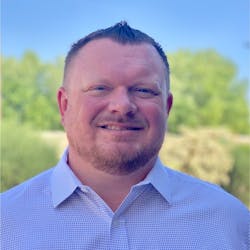
Name: Jerry Crump
Job Title: Director of Sales / Marketing
Company: Wollard International
Location: Eau Claire, WI
Years in Ground Support industry: 25
Years with Current Company: 1.5
Previous Employers: United State Marine Corps, Swissport USA, Somerset Capital, Virgin Galactic, Webasto Charging Solutions, Green Cubes
Ground Support Worldwide: What attracted you to a career in the ground support industry?
Jerry Crump: Funny enough I chose 6000 Series MOS at the Marine Corps recruiting station. That MOS series encompasses all of the aviation jobs within the Marine Corps. It was not until I graduated boot camp that I truly understood what GSE was. After being hired by Swissport from ERAU Daytona Beach I saw a pushback in SFO that Wollard manufactures for the US Military go rolling by. After pointing out I knew what those were, my brief stint of about three months outside of GSE came to an end.
GSW: What has kept you engaged in the industry?
JC: To be totally honest in the last 25 years I have watched and participated in a lot of the change that has happened in the industry around green technology, and even space tourism. These changes, combined with the opportunities I’ve had helping customers (internal or external) find solutions that fit with their operational needs and incorporating these changes keeps me engaged. More than that, this industry has some amazing people I have developed relationships with over the years and that I would sorely miss if I ever stepped away.
GSW: What’s the best advice you’ve been given while working in this field?
JC: When I was coming up in the industry, I was lucky enough to have a few good mentors. I was even luckier to have folks that were open to sharing their experience, or thoughts on how to best accomplish operational goals. For those of you that are reading this today, thank you! I think the single most enlightening insight was when I was given an understanding as to the size of our industry. To think that billions of passengers fly annually around the world, yet there are so few in the GSE industry in comparison.
GSW: What role has eGSE played in advancing the ground support industry?
JC: Some of our fleets are very old, but that is because the old technology worked without much more training than we got on the farm, or in our driveways. However, these older fleets are not always more reliable simply because they may be simpler technology to work on.
eGSE has gone through its own growing pains, and the learning curves have been steep at times. When I first looked at eGSE in 2008, some of those ahead of me had been dealing with DC drive systems, and the maintenance issues involving them. This translated to some reluctance toward eGSE at the time, even though drive systems were migrating to AC motors.
Now we are watching as more fleets are making the move to lithium from the lead acid technology that we have spent over two decades coming to understand. This transition drives changes to both engineering and design due to performance advantages. Where some systems had rapid energy capture and discharge, or extra battery capacity designed into them for lead acid they may be able to reduce capacity and complexity by swapping the battery type to lithium.
New technology such as lithium batteries do bring advantages, but it also comes with a need for possible change in infrastructure, training and operational processes. In the end eGSE seems to be driving some additional upfront cost due to the need to support it such as infrastructure but in the end, it is cheaper to operate, more reliable, and healthier for the operators.
GSW: How do expect continued advancements and new technology will influence the eGSE space?
JC: I think as we continue to see commercially available components become more advanced and robust we will see them incorporated into GSE. With GSE being such a small market, we are highly reliant upon other industries making many of our components and then adapting what we can to our environment.
As other more industrial applications make the switch to purely electric, or even some type of hybrid application, it will allow for us to have a wider range of components to choose from. I expect that at one point the zero emission ramp initiatives will drive differing infrastructure as well such as high voltage or possibly hydrogen.
GSW: How have you seen the ground support industry change the most during your career?
JC: The change from internal combustion motors to electric has been the largest change across the industry. During my time at JFK, almost all our engines had little to no emission controls, and now we are just a short time away from having zero emission ramps. This can only be made possible by GSE manufacturers making equipment that can take the place of the internal combustion equivalents, airport infrastructure investments and the adaptation of new technology by the GSE community.
GSW: Has this change been to the benefit or detriment of the industry?
JC: Both. Some operators are forced to make these changes without the airport being able to fully support the infrastructure needs. This leads to poor uptime, fleets that are not necessarily right sized, or drastic measures to add temporary infrastructure. The opposite is true of airports that work with their customers to plan properly and add the infrastructure in a smart and efficient manner. Those that work with and collaborate with their customers have had some great success stories.
GSW: What’s the next big thing coming to the ground support industry?
JC: High voltage as a norm. When you look at the different projects that are driving high voltage, such as air mobility, electric aircraft, and EV ramp vehicles, all of these are going to drive additional high voltage infrastructure. Then the question remains for these airports that are getting older: How will they support this additional need? It seems that everything we do these days is attached to the grid at some point. Either through local energy generation, microgrids or some other technology we will need to boost the capacity at the airports. This will continue until we make a change to that next fuel source of the future.
GSW: What type of an impact will it make?
JC: I think it will continue to drive a need for better planning. When municipalities and airports make their long-terms plans, I doubt they understood the exponential growth in demand placed on their grids by the changes and adaptation in technology. Thirty years ago, you could still find a pay phone to make calls. Now we are all looking for an outlet to plug in our cell phones. As we continue to improve the efficiency of our electronic components, we create more and more demand for reliable energy.
GSW: What would you say to encourage someone to join the ground support industry?
JC: GSE – believe it or not – is a much more technical industry than it gets credit for. If you look at all of the different systems GSE utilize to make sure that aircraft are safely serviced while on the ground, it is no wonder we have such a hard time finding great technicians.
However, if you like working on a different problem every day, like being around aircraft and good people, it can be an industry to build a career around. If you had asked me 25 years ago when I took my first class in Pensacola if I would still be in GSE all these years later, I don’t think my answer would have been yes. If you ask me now if I would ever leave, the answer is no.
About the Author
Josh Smith
Editor
Josh Smith served as editor of Ground Support Worldwide as editor from 2016 through 2024. He oversaw production of the print magazine, created GSW's newsletters on a daily basis, and updated the latest news on AviationPros.com.
